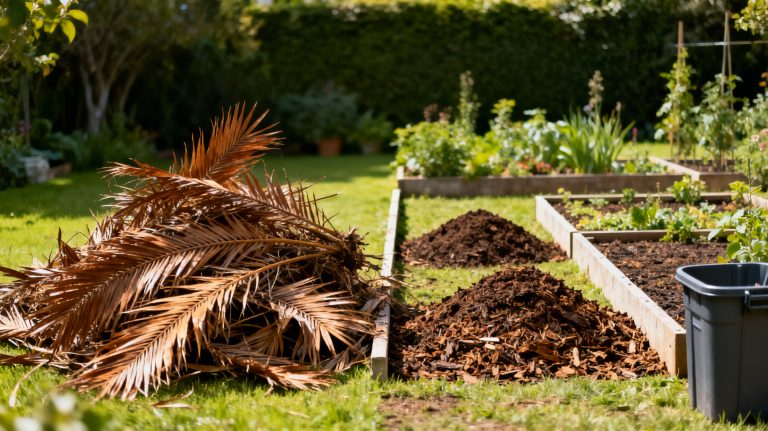Clear that pile in under 3 hours. Right now you’re wondering what to do with palm fronds that are too stiff for the bin and too many to ignore. Here’s the shift: a 10-minute decision tree—yard size, local rules, frond condition—hands you three proven paths. Mulch in 2-3 inch layers and cut future piles by 50%. Hot compost in a 3x3x3 bin if you have space and want soil in 5-7 days. Or schedule pickup within the week; most suburbs offer it free if you know the right day. You’ll get the sorting step, the safety check, and the exact method so the fire risk and rodent threat are gone by lunch. Every day fronds sit dry, they become kindling; every day they sit wet, they invite pests. Grab gloves and a tarp—step one is a 60-second sort and dry-out.
Sort Fronds First, Do a Safety Check
Do this once and your decision gets simple.
- Separate by condition:
- Dry, brown, brittle = best for reuse/mulch/compost.
- Green, fresh cut = let dry 1-2 weeks so they don’t clog tools or go slimy.
- Suspect/diseased = bag and dispose. Red flags: soft rot smell, black streaking, mushy bases, or fronds from a tree recently treated for a serious disease.
- Suit up: sturdy gloves, long sleeves, eye protection. Some palms have hidden spines. Frond bases can be sharp.
- Keep piles off the house/fence. Frond stacks can shelter rodents and retain moisture.
Quick Check, Reuse or Dispose Now
Both reuse and disposal can be “right.” The fork in the road is health and dryness. If a frond snaps cleanly and shows no moldy patches, it’s a reuse candidate. If it smells sour or shows black ooze, don’t mulch or compost it dispose.
Why Palm Fronds Decompose Slowly, Lignin and Waxy Layers
Palm fronds are tough by design. They’re high in lignin with a waxy outer layer, which is great for surviving wind and sun but slow for microbes to digest. Whole fronds can take a year or more to break down. Shredding and mixing with “greens” (nitrogen rich materials) speeds things up. Dumping long, green fronds into a pile does the opposite by packing tight and going anaerobic. Municipal programs vary because of this some composters can’t process palms efficiently, so fronds are restricted or handled separately.
Quick Decision Guide, Reuse, Mulch, or Dispose
- If your city accepts palm fronds in green waste or offers bulky pickup: Use it. It’s often the fastest, most responsible move for large piles.
- If they don’t accept fronds or charge a lot: Reuse on site as mulch or in garden structures, or compost with intention (see below).
- Tiny yard or HOA constraints: Aim for curbside pickup, community green waste drop off, or compact reuse (edging, small layer compost).
- Big yard or a slope: Reuse shines coarse mulch, erosion control, or hugelkultur type beds are practical and free.
- Indoor fern fronds (small amounts): They’re softer. You can compost them easily or chop and use as houseplant mulch.
Activation Point, Check Local Palm Frond Rules
Check your local rules now. Some cities ban palm fronds in the green bin. Others offer special palm only pickups or free drop off days.
Mulch First, Easiest Win for Most Yards
If the fronds are dry and disease free, mulching is usually the lowest effort reuse.
- Preparation: Let green fronds dry until they’re lighter in color and snap instead of bend (typically 1-2 weeks in dry weather).
- Processing: Shredding is best, but regular chippers can tangle. “Silent” or slow roll chippers work better on fibrous material. No chipper? Cut fronds into short pieces with loppers/pruning saw, or lay a few at a time on the lawn and run them over with a mower (bag on).
- Application: Use as a coarse, airy mulch 2-3 inches deep around trees and beds. Keep it a few inches away from trunks and house foundations. Don’t bury drip emitters.
You’ll know it’s working when the soil under the mulch stays damp longer after watering (often noticeable within 24-48 hours). In 5-7 days, the top layer looks drier while the soil beneath stays cool a good sign you’ve got airflow and moisture balance.
Notes That Matter, Mulch Safety and Use
- Skip mulching with fronds from a diseased palm. Dispose instead.
- Coarse frond mulch breaks down slowly great for paths and low maintenance beds.
- Don’t stack mulch against palm trunks or woody stems. It can trap moisture where you don’t want it.
Composting Paths, From Fast and Managed to Set and Forget
You can compost palm fronds, but choose the method that fits your energy level.
-
Hot compost (managed, faster):
- Shred or chop fronds small. Mix roughly equal volumes of shredded fronds (brown) with high nitrogen greens (fresh clippings, manure, kitchen scraps) to avoid a dry, carbon heavy pile.
- Build at least a 3x3x3 foot pile, moist like a wrung out sponge, and turn every few days to keep it aerated.
- Good sign: The pile feels hot to the touch within 24-48 hours and steams on a cool morning when turned around day 5-7. With consistency, expect usable compost in a few months.
-
No dig layering (low effort, slower):
- Lay fronds flat as the bottom layer in a bed or along paths. Top with greens and regular yard waste. Water each layer as you go.
- Expect breakdown on the order of a year or more. It’s tidy and functional, just slow.
-
Hügelkultur style mounds:
- Use fronds as part of the coarse base layer, then alternate browns and greens on top.
- It doubles as a planting bed while the buried material slowly feeds the system.
Essential Tip, Dry Fronds Before Shredding
Always let fresh cut fronds dry before shredding. Green frond shreds pack into dense, airless mats that stall decomposition.
Disposal Done Right, City Rules and Pickup Options
If composting or reuse doesn’t fit your yard or your pile, choose disposal and move on it’s still a responsible choice when done right. Call your hauler or check your city’s website for palm specific rules. Some programs allow tied bundles for green waste. Others exclude palms from the green bin but offer separate bulky pickups or a palm only drop off. If self-hauling, ask whether palms are accepted as green waste or charged differently (many sites sort them separately because they break down slowly). Tie bundles with natural fiber twine, cut to manageable lengths, and keep them free of wire or trash.
Good Sign After Pickup, Clear Area and Fewer Rodents
fewer rodents poking around and your staging area cleared usually within the week once scheduled.
Reuse Ideas That Work, Edging, Windbreaks, Erosion Control
- Path or bed edging: Lay trimmed frond ribs along borders like rustic bender board. Pin with landscape staples.
- Brush fence/windbreak: Stack fronds between T posts to make a quick privacy or garden windbreak. Not against structures.
- Erosion control on slopes: Lay fronds perpendicular to the fall line and peg them in. They trap mulch and slow runoff.
- Habitat pile: In a back corner, a neat, elevated brush pile supports beneficial critters. Keep 20+ feet from buildings.
- Crafts: Dried fronds can be woven into simple screens or seasonal decor. Avoid indoor burning palms pop and soot.
If you’re in an apartment with only a few fern fronds, chop and add to a countertop compost pail or use as a thin mulch layer in planters.
Prevent the Pile Next Time, Trim and Stage Smarter
Trim only fully dead, brown fronds browning at the tips is normal aging, not an emergency. Cut into manageable lengths as you go so future handling is easy. Stage a drying spot where fronds can crisp up before processing. If you’re constantly buried in debris, consider a maintenance schedule or, long term, favor palms that self-shed cleanly for the garden benefits of palms. And when storms drop a lot at once, prioritize safety and clearing access. You can decide reuse vs. disposal after they’re dry and out of the way.
Whether you DIY or call us, you don’t have to wrestle fronds alone. We can do on site shredding that won’t jam on fibrous material, separate diseased debris for proper disposal, and line up city compliant hauling when that’s the smarter move. Most visits end with a tidy mulch layer or a scheduled palm only pickup either way, you get your space back and a clear plan. We can usually fit assessments in the same week.













